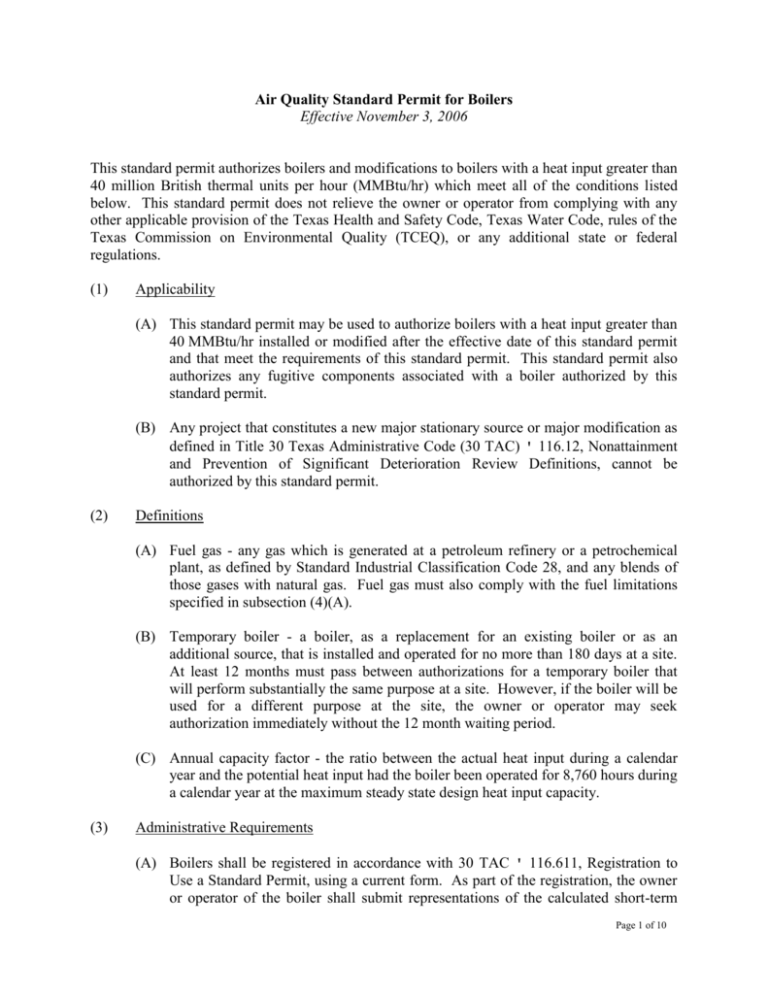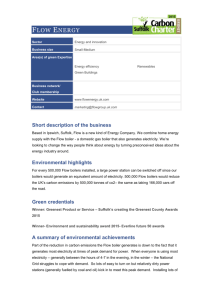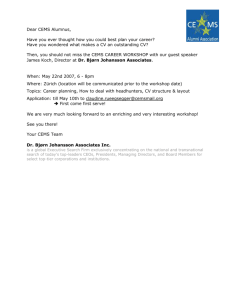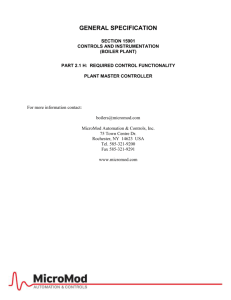Air Quality Standard Permit for Boilers Effective November 3, 2006
advertisement

Air Quality Standard Permit for Boilers Effective November 3, 2006 This standard permit authorizes boilers and modifications to boilers with a heat input greater than 40 million British thermal units per hour (MMBtu/hr) which meet all of the conditions listed below. This standard permit does not relieve the owner or operator from complying with any other applicable provision of the Texas Health and Safety Code, Texas Water Code, rules of the Texas Commission on Environmental Quality (TCEQ), or any additional state or federal regulations. (1) Applicability (A) This standard permit may be used to authorize boilers with a heat input greater than 40 MMBtu/hr installed or modified after the effective date of this standard permit and that meet the requirements of this standard permit. This standard permit also authorizes any fugitive components associated with a boiler authorized by this standard permit. (B) Any project that constitutes a new major stationary source or major modification as defined in Title 30 Texas Administrative Code (30 TAC) ' 116.12, Nonattainment and Prevention of Significant Deterioration Review Definitions, cannot be authorized by this standard permit. (2) Definitions (A) Fuel gas - any gas which is generated at a petroleum refinery or a petrochemical plant, as defined by Standard Industrial Classification Code 28, and any blends of those gases with natural gas. Fuel gas must also comply with the fuel limitations specified in subsection (4)(A). (B) Temporary boiler - a boiler, as a replacement for an existing boiler or as an additional source, that is installed and operated for no more than 180 days at a site. At least 12 months must pass between authorizations for a temporary boiler that will perform substantially the same purpose at a site. However, if the boiler will be used for a different purpose at the site, the owner or operator may seek authorization immediately without the 12 month waiting period. (C) Annual capacity factor - the ratio between the actual heat input during a calendar year and the potential heat input had the boiler been operated for 8,760 hours during a calendar year at the maximum steady state design heat input capacity. (3) Administrative Requirements (A) Boilers shall be registered in accordance with 30 TAC ' 116.611, Registration to Use a Standard Permit, using a current form. As part of the registration, the owner or operator of the boiler shall submit representations of the calculated short-term Page 1 of 10 and long-term emission limits, including maintenance, startup, and shutdown emissions, using a current Table 1(a), Emission Point Summary, and the annual capacity factor. These emission and operating limitations shall become an enforceable part of the authorization upon approval. Units which meet the conditions of this standard permit do not have to meet 30 TAC ' 116.610(a)(1), Applicability. (B) Registrations shall comply with 30 TAC ' 116.614, Standard Permit Fees, for any single unit or combination of units to be authorized by a single registration. (C) No owner or operator of a boiler shall begin construction or operation without first obtaining written approval of registration from the executive director. (D) Boilers must meet the applicable conditions, including testing and performance standards, of Title 40 Code of Federal Regulations (40 CFR) Part 60, Subpart Da, Standards of Performance for Electric Utility Steam Generating Units for Which Construction is Commenced After September 18, 1978; Subpart Db, Standards of Performance for Industrial-Commercial-Institutional Steam Generating Units; or Subpart Dc, Standards of Performance for Small Industrial-CommercialInstitutional Steam Generating Units. (E) Compliance with this standard permit does not exempt the owner or operator from complying with any applicable requirements of 30 TAC Chapter 117, Control of Air Pollution from Nitrogen Compounds. (4) General Requirements (A) Fuel Limitations (i) All references to emission limits and boiler sizes in this standard permit are based on the higher heating value of the fuel. (ii) Fuel for a boiler may consist of fuel gas or natural gas. As fired in the boiler, the fuel must contain no greater than 10 grains of total sulfur and 10 grains of hydrogen sulfide per 100 dry standard cubic feet (scf). The permit holder is responsible for complying with 40 CFR Part 60, Subpart J, Standards of Performance for Petroleum Refineries, if applicable. Also, as fired in the boiler, the fuel must contain less than 50 percent hydrogen, contain no alkynes, and have a higher heating value of at least 900 Btu/scf. (iii) Boilers may be fired up to 720 hours per year with liquid fuel that does not contain waste solvents and has a sulfur content of less than or equal to 0.05 percent by weight. (iv) For boilers with a heat input of 100 MMBtu/hr or greater, the holder of this permit shall additionally monitor and record the average hourly gaseous fuel consumption of the boiler. Page 2 of 10 (v) No boiler shall be authorized under this standard permit for use as a control device for a process stream. This does not preclude the use of other forms of authorization such as 30 TAC Chapter 106, Permits by Rule, to add additional fuel sources once the boiler is authorized under this standard permit. (B) Emission Limits (i) Hourly emissions limits are one-hour block averages for nitrogen oxides (NOx) and three hour block averages for carbon monoxide (CO). (ii) Emissions of NOx from any new or existing boiler not intended as a temporary boiler shall not exceed 0.01 pound (lb) per MMBtu for boilers fired on fuel deriving more than 75 percent of its heating value from natural gas or 0.015 lb/MMBtu for boilers fired on fuel deriving less than or equal to 75 percent of its heating value from natural gas. (iii) Emissions of NOx from any temporary boiler shall not exceed 0.036 lb/MMBtu. (iv) For boilers with a maximum heat input of less than 100 MMBtu/hr and an annual capacity factor of 0.30 or less, in place of the NOx emission limit in paragraph (B)(ii), the NOx emission limit of the boiler shall be 0.036 lb/MMBtu for any fuel. (v) Emissions of CO shall not exceed 50 parts per million by volume on a dry basis (ppmvd) corrected to 3 percent oxygen (O2). (vi) Emissions of ammonia (NH3) from any boiler using NH3 or urea-based control technology shall not exceed 10 ppmvd corrected to 3 percent O2. (vii) Opacity of emissions from the boiler shall not exceed 5 percent averaged over a six-minute period. Opacity shall be determined by the U.S. Environmental Protection Agency (EPA) Test Method 9 during the initial compliance testing and at least once per year thereafter. (C) Controls (i) Modifications such as burner replacement or the installation of flue gas recirculation on existing boilers to meet the emissions requirements of subsection (4)(B) are authorized by this standard permit. (ii) The installation of selective catalytic reduction (SCR) units in order to achieve the emission limits of subsection (4)(B) are authorized by this standard permit. Additionally, any storage tanks, piping, or other equipment necessary to supply NH3 to the SCR and their associated fugitives are authorized. Audio, olfactory, and visual checks for NH3 leaks within the operating area shall be Page 3 of 10 made at least once per day. Unless the site has undergone the appropriate review under 40 CFR Part 68, Chemical Accident Prevention Provisions, or the NH3 kept on site is an amount less than the threshold values in 40 CFR ' 68.130, List of Substances, only aqueous NH3 no greater than 20 percent concentration by volume shall be stored on site. (D) Maintenance, Startup, and Shutdown (i) Emissions of NOx from any boiler shall not exceed 0.10 lb/MMBtu during maintenance, startup, and shutdown. (ii) Emissions of CO from any boiler shall not exceed 500 ppmvd during maintenance, startup, and shutdown. (iii) Opacity shall not exceed the limits set forth in 30 TAC Chapter 111, Control of Air Pollution from Visible Emissions and Particulate Matter, during maintenance, startup, and shutdown. (iv) Warm startup events shall not exceed four hours in duration. Cold startup events shall not exceed eight hours in duration. Shutdown events shall not exceed one hour. (v) Emissions from upset events as defined in 30 TAC Chapter 101, General Air Quality Rules, are not authorized by this standard permit. (E) Stack Height Requirement. Each boiler authorized under this standard permit shall have a stack with a minimum height as determined by the following equation: H = 0.04 Q + 8.20 Where: H = Minimum stack height above ground level in feet (ft) Q = Maximum boiler heat input in MMBtu/hr (5) Initial Compliance Testing (A) Sampling ports and platform(s) shall be incorporated into the design of the stack according to the specifications set forth in Chapter 2 of the TCEQ guidance document entitled “Sampling Procedures Manual.” Alternate sampling facility designs may be submitted for approval to the TCEQ Regional Director or the Director of the TCEQ Compliance Support Division in Austin. (B) The holder of this standard permit shall perform stack sampling and other testing as required to establish the actual pattern and quantities of air contaminants being emitted into the atmosphere from the boiler. The holder of this standard permit is responsible for providing sampling and testing facilities and conducting the Page 4 of 10 sampling and testing operations at his or her expense. (i) (ii) The appropriate TCEQ Regional Office and local air pollution control agencies having jurisdiction shall be contacted as soon as testing is scheduled but not less than 45 days prior to sampling to schedule a pretest meeting. The notice shall include: (a) the date for pretest meeting; (b) the date sampling will occur; (c) the name of firm conducting sampling; (d) the type of sampling equipment to be used; and (e) the method or procedure to be used in sampling. A written proposed description of any deviation from sampling procedures specified in permit conditions or the TCEQ or EPA sampling procedures shall be made available to the TCEQ prior to the pretest meeting. The appropriate TCEQ Regional Director or the Director of the TCEQ Compliance Support Division in Austin shall approve or disapprove of any deviation from specified sampling procedures. (iii) Requests to waive testing for any pollutant specified in this condition shall be submitted to the TCEQ Office of Permitting, Remediation, and Registration, Air Permits Division. Test waivers and alternate or equivalent procedure proposals for testing under 40 CFR Part 60, Standards of Performance for New Stationary Sources, which must have the EPA approval shall be submitted to the TCEQ Compliance Support Division in Austin. (iv) Air contaminants emitted from the boiler to be tested at maximum heat input include, but are not limited to, NOx, CO, O2, and NH3, if applicable. If fuel gas will be used, the boiler must fire the maximum percentage of the nonnatural gas part of the fuel gas intended during normal operation for this test. Future increases in the percentage of fuel gas in the boiler fuel or significant changes in fuel gas composition will require approval of the appropriate TCEQ Regional Director and could include retesting under this condition. (v) Sampling shall occur within 90 days after installation or modification of the boiler. Requests for additional time to perform sampling shall be submitted to the appropriate TCEQ Regional Office. Additional time to comply with the applicable requirements of 40 CFR Part 60 requires EPA approval, and requests shall be submitted to the TCEQ Compliance Support Division in Austin. (vi) Copies of the final sampling report shall be submitted to the appropriate Page 5 of 10 TCEQ Regional Office and any local air pollution control agencies having jurisdiction within 60 days after sampling is completed. Sampling reports shall comply with the provisions of Chapter 14 of the TCEQ “Sampling Procedures Manual.” (vii) For temporary boilers that have been tested at another site located in Texas, the previous testing shall be acceptable and another initial test is not necessary, provided the last sampling report was deemed acceptable by the TCEQ Regional Office to which it was submitted. (6) Continuous Demonstration of Compliance (A) The holder of this standard permit for a boiler with a maximum potential heat input of 100 MMBtu/hr or greater and any boiler with a SCR shall install, calibrate, maintain, and operate a continuous emission monitor system (CEMS) to determine the in-stack concentration of NOx. Additionally, a CEMS is required for CO for a boiler with a maximum potential heat input of 250 MMBtu/hr or greater. Boilers without a CEMS for NOx shall perform the testing procedure of section (5) every three years after the completion of the initial boiler testing. For this continuous demonstration of compliance, paragraph (5)(B)(v) shall mean 90 days after the anniversary date of the completion of the initial test. (B) CEMS requirements. The owner or operator of any CEMS must comply with the following. (i) The CEMS shall meet the requirements of 40 CFR Part 60 as follows: (a) Section 60.13, Monitoring Requirements; (b) Appendix B, Performance Specifications: (c) (1) Performance Specification 2, for NOx in terms of lb/MMBtu. An alternative relative accuracy requirement of 2.0 ppmv from the reference method mean value is allowed; (2) Performance Specification 3, for diluent; and (3) Performance Specification 4, for CO, for owners or operators required to use a CO CEMS. Appendix F, Quality Assurance Procedures: (1) For boilers with a heat input of less than 250 MMBtu/hr, conduct audits for NOx, CO, and diluent analyzers in accordance with ' 5.1 of Appendix F, except that a cylinder gas audit (CGA) or relative accuracy audit may be performed in lieu of the annual relative accuracy test audit (RATA) required in ' 5.1.1. However, Page 6 of 10 if the optional alternative relative accuracy requirement of subclause (b)(1) (or equivalent) from the reference method mean value is used, then an annual RATA must be performed. (2) (ii) For boilers with a heat input of 250 MMBtu/hr or greater, conduct audits for NOx, CO, and diluent analyzers in accordance with ' 5.1 of Appendix F. There shall be a verbal notification to the appropriate TCEQ Regional Office of the date of any CEMS RATA at least 15 days prior to such date followed by written notification within 15 days after testing is completed. Monitor diluent, either O2 or carbon dioxide. (iii) Sharing of CEMS. (a) (b) One CEMS may be shared among units, provided: (1) the exhaust stream of each stack is analyzed separately; and (2) the CEMS meets the certification requirements of paragraph (i) for each stack while the CEMS is operating in the time-shared mode. Exhaust streams of units which vent to a common stack do not need to be analyzed separately. (iv) If subject to 40 CFR Part 75, Continuous Emission Monitoring, as an alternative to paragraph (i), an owner or operator may choose to comply with the CEMS requirements of 40 CFR Part 75. (v) The owner or operator shall use one of the following methods to provide substitute emissions compliance data during periods when the NOx CEMS is off-line: (a) use the missing data procedures specified in 40 CFR Part 75, Subpart D, Missing Data Substitution Procedures; or (b) use the maximum block one-hour emission rate as measured during the initial demonstration of compliance. (C) One of the following NH3 monitoring procedures shall be used to demonstrate compliance with the NH3 emission limit of subsection (4)(B) for boilers which inject urea or NH3 into the exhaust stream for NO x control. (i) Mass balance. Calculate NH3 emissions as the difference between the input NH3, measured by the NH3 injection rate, and the NH3 reacted, measured by the differential NOx upstream and downstream of the control device which injects urea or NH3 into the exhaust stream. The equation is: Page 7 of 10 NH3 = [(1.71) x (a/b) x (106) - c] x d Where: NH3 = NH3 concentration on a dry basis in ppmv at 3 percent O2 a = NH3 injection rate in lb/hr b = dry exhaust flow rate in lb/hr c = change in measured NOx concentration across catalyst in ppmv at 3 percent O2 d = correction factor, the ratio of measured slip to calculated NH3slip, where the measured slip is obtained from the stack sampling for NH3 required by section (5), using either the PhenolNitroprusside Method, the Indophenol Method, or EPA Conditional Test Method 27. (7) (ii) Oxidation of NH3 to nitric oxide (NO). Convert NH3 to NO using molybdenum oxidizer and measure NH3 slip by difference using a NO analyzer. The NO analyzer shall be quality-assured in accordance with manufacturer’s specifications and with a quarterly CGA with a ten ppmv reference sample of NH3 passed through the probe and confirming monitor response to within " 2.0 ppmv. (iii) Stain tubes. Measure NH3 using a sorbent or stain tube device specific for NH3 measurement in the 5.0 to 10.0 ppmv range. The frequency of sorbent or stain tube testing shall be daily for the first 60 days of operation, after which the frequency may be reduced to weekly testing if operating procedures have been developed to prevent excess amounts of NH3 from being introduced in the control device and when operation of the control device has been proven successful with regard to controlling NH3 slip. Daily sorbent or stain tube testing shall resume when the catalyst is within 30 days of its useful life expectancy. Every effort shall be made to take at least one weekly sample near the normal highest NH3 injection rate. (iv) Other methods. Monitor NH3 using another CEMS or predictive emissions monitoring system procedure subject to prior approval of the executive director. For purposes of this paragraph, the executive director is the TCEQ, Compliance Support Division. Recordkeeping (A) Records, written or electronic, shall be maintained for a period of at least five years and made readily available, upon request, for inspection by the executive director, the EPA, and any local air pollution control agency having jurisdiction. Additionally, a copy of the initial permit application and initial testing reports shall be kept on site for the life of the permit. Page 8 of 10 (B) (C) (8) All boilers must keep the following records. (i) Startup and shutdown records. Hourly records shall be made of startup and/or shutdown events. These records shall include (but are not limited to) the following: type of fuel burned; quantity of each type of fuel burned; emissions from the event; and the date, time, and duration of the event. (ii) Maintenance records. Records shall be made of maintenance events. These records shall include (but are not limited to) the following: type of fuel burned; quantity of each type of fuel burned; emissions from the event; and the date, time, and duration of the procedure. (iii) Emissions records. Records shall be made to demonstrate that the emissions of the unit have not exceeded the limits set forth in this standard permit. These records shall include (but are not limited to) the type of fuel burned and quantity of each type of fuel burned. (iv) NH3 monitoring for units using NH3 or urea. The owner or operator shall maintain records which are sufficient to demonstrate compliance with the requirements of the appropriate paragraph of subsection (6)(C). For the sorbent or stain tube option, these records shall include the NH3 injection rate and NOx stack emissions measured during each sorbent or stain tube test. (v) Temporary boilers. Records shall be made to demonstrate that all temporary boilers authorized by this standard permit comply with subsection (2)(B) and paragraph (4)(B)(iii). For boilers with a CEMS, records shall include: (i) raw CEMS data; (ii) monitoring records of hourly emissions and fuel usage (or stack exhaust flow). Emissions must be recorded in units of lb/MMBtu for NOx, ppm for CO, and lb/hr for NOx and CO; and (iii) records of the results of any certification testing, evaluations, calibrations, checks, adjustments, and maintenance of any CEMS. Reporting for Boilers with CEMS (A) The owner or operator of any boiler required to install a CEMS under 40 CFR Part 60 shall comply with the reporting requirements of that regulation. (B) The owner or operator of any boiler electing to install a CEMS shall submit Page 9 of 10 annual reports to the appropriate TCEQ Regional Office and local air pollution control agencies having jurisdiction which include the following information: (i) the magnitude of excess emissions computed in accordance with 40 CFR § 60.13(h), any conversion factors used, the date and time of commencement and completion of each time period of excess emissions, and the unit operating time during the reporting period; (ii) specific identification of each period of excess emissions that occurs during startups, shutdowns, and malfunctions of the affected unit, the nature and cause of any malfunction (if known), and the corrective action taken or preventative measures adopted; (iii) the date and time identifying each period during which the CEMS was inoperative, except for zero and span checks, and the nature of the system repairs or adjustments; (iv) when no excess emissions have occurred or the CEMS has not been inoperative, repaired, or adjusted, such information shall be stated in the report; and (v) if the total duration of excess emissions for the reporting period is less than 1.0 percent of the total unit operating time for the reporting period and the CEMS downtime for the reporting period is less than 5.0 percent of the total unit operating time for the reporting period, only a summary report form (as outlined in the latest edition of the TCEQ guidance document entitled “Guidance for Preparation of Summary, Excess Emission, and Continuous Monitoring System Reports”) shall be submitted, unless otherwise requested by the executive director. If the total duration of excess emissions for the reporting period is greater than or equal to 1.0 percent of the total operating time for the reporting period or the CEMS downtime for the reporting period is greater than or equal to 5.0 percent of the total operating time for the reporting period, a summary report and an excess emission report shall both be submitted. Page 10 of 10





